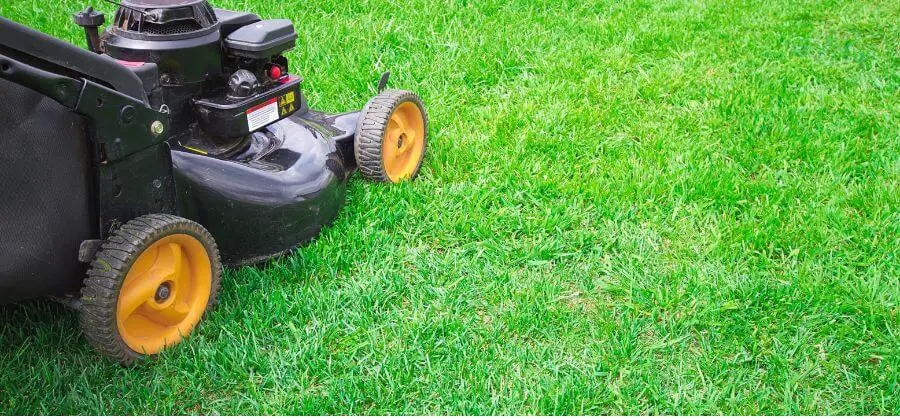Even though sod can help you have a lush, green lawn nearly right away after moving into a new house, it still takes some time to settle down and build strong roots before being treated like any other lawn. A sod’s growth, however, can also be hampered by delaying some simple care tasks, such as the initial mow.
So you decided to invest in a lush new lawn and had newly installed sod. Now you’re impatiently looking out the window, wondering when you’ll be able to break out the mower and start manicuring that cut grass.
The waiting period after laying new sod can seem agonizing, but trust us, it’s critical. If you mow too early, you risk damaging the new grass before its roots have time to properly establish themselves. Mow prematurely, and you’ll end up with dead spots, an uneven lawn, and a lot of wasted money.
How long to wait before mowing new sod? It probably crosses your mind if you recently had sod installed or are thinking about it in the future. To time something perfectly, learn exactly how long to wait and why.
Why You Should Wait Before Mowing New Sod?
New sod needs time to establish roots before getting its first trim. Grass damage and growth inhibition can result from premature mowing. Here are some of the causes:
New sod has been cut from its roots, so it needs time to grow new roots in your soil. This usually takes at least 2 to 3 weeks. Mowing early can rip these fragile new roots right out of the ground before they’ve anchored in.
Mow sod also needs time to overcome the stress of being handled, moved, and laid in place. Give your grass at least 10 to 14 days to recover from this shock before mowing. The sod will look a bit ragged at first but will fill in and green up over this period.
Once the sod has rooted and recovered, the first mowing should be done with care. Set your mower to a high blade height, around 3 to 12 inches. This will trim the grass without cutting more than 1/3 of its height. After the first mowing, continue mowing regularly to encourage your new lawn to thicken up.
With patience and the right mowing technique, your new sod will establish itself and thrive. Before you know it, you’ll have a lush, healthy lawn to enjoy all season long! Take it slow; the rewards will be worth the wait.
The Importance of Root Establishment
Once your newly installed sod is ready, the most important thing is to give the grass time to establish roots in the soil. This usually takes 10 to 14 days, so try to be patient!
During this initial period, limit foot traffic and activity on the new lawn as much as possible. This means keeping kids and pets off the grass until the roots have anchored. Any disruption can damage the tender roots before they’ve had the chance to spread out and grab hold.
You’ll also want to water the new mow sod thoroughly and frequently, especially for the first week. Aim to keep the top few inches of soil moist at all times. The more you water, the faster the roots will establish themselves.
Mowing the New Lawn
After 10 to 14 days, you can do an initial mowing to about 2 to 3 inches high. Make sure the roots are anchored by gently tugging on the edges of a piece of sod; it should feel firmly rooted in place and resist pulling up.
For the first few mowings, never cut off more than 1/3 of the grass blade at a time. This means you may need to mow more frequently at first, about every 4 to 5 days. Mowing gradually and avoiding shock will ensure your new lawn gets off to the best start.
With the proper care and patience, your new sod can establish healthy root growth and thrive. You may enjoy your beautiful, green grass all season long before you know it! Keep up the fine work, and soon everyone in the neighborhood will be envious of you.
How to Properly Mow New Sod for the First Time?
Now that your new sod has been laid, it’s important to know when and how to mow it for the first time. Rushing into mowing too soon can damage the new grass before its roots have been fully established. However, waiting too long between installation and the initial mowing can also cause issues.
When is the Sod Established Enough to Mow?
Before mowing for the first time after installing fresh sod, you should give it 10 to 14 days. The grass blades will have begun to interlock at this time, and the roots will have started to firmly anchor themselves in the ground. Check for signs your new lawn is ready:
- The blades of grass are 2 to 3 inches tall.
- By lightly tugging on the new sod, roots have been safe in many locations. It should feel firmly rooted and resistant to pulling up.
- No visible bare or dead spots remain. All pieces should be green, lush, and actively growing.
How Do I Properly Mow New Sod?
When it’s time for the initial mowing, follow these key steps:
- Set your lawn care mower to a high blade setting, around 3 to 12 inches. This will only trim the tops of the grass blades, not shock the new lawn.
- Mow during the late afternoon when the grass is dry. Mowing when wet can damage the new sod.
- Make multiple passes over the lawn, lowering the mower setting by 12 inches with each pass. This gradual cutting will allow the new sod to adjust slowly to mowing.
- Never remove more than 13 percent of the total grass blade length at a time. So if your new sod is 3 inches tall, do not cut it shorter than 2 inches on the first mowing.
- Keeping these tips in mind will ensure your new lawn gets off to the best start. Mowing properly and at the right time is key to helping your new sod establish healthy roots and thrive.
Conclusion
Patience is key when it comes to new sod; give your lawn at least two to three weeks of undisturbed rest before breaking out the mower. Resist the urge to start mowing too early, even if the grass looks like it needs a trim. Those early days of establishment are critical for the new roots to take hold.
Once you do start mowing, take it slow. Keep the blade high at first, around 3 inches, and never take off more than 1/3 of the grass blade at a time. Gradually lower the height over a few mowings as the sod continues to strengthen its hold in your yard. Take a step back and let your new sod work its magic—your perfect lawn care awaits!
FAQs
How long does it take for the sod to establish itself?
This is dependent on the time of year. Sod takes root more quickly the warmer it is. In the summer, it should take five to fifteen days for your sod to take root; in the winter, it should take twenty to thirty days.
When should fresh sod be fertilized?
To give your new sod time to take root and adapt to your yard, you should wait 30 days following installation before fertilizing it. Before cutting the new sod, how long should I wait? To prevent any damage to the roots, you should wait 14 days before your first mow.
Will A Dead Lawn Re-sod?
Dead grass cannot be revived, but you can re-grow your landscape by installing new sod. Brown, bare, or thinned-out patches in your beautiful lawn are definite indications that you need to plant fresh seed or replace the sod.
Do sod leaves first become brown, then green?
Even if the sod you buy for your yard is dormant and brown, it can still be set up as soon as possible. You may effectively lay sod on your lawn with the right upkeep, watering, and soil care, and when the dormant season is over, it will become a lovely green.
For more lawn care tips visit here and for more guides related to mowers visit Mowers Guide








